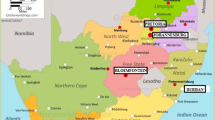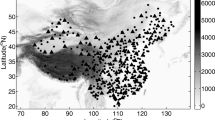Abstract
From several towers in Hami, Xinjiang of Northwest China, built by the national wind power resources professional observation network, we selected three towers with synchronous 10-min average wind speed data for one year (May 2011–April 2012) under strict quality control. The towers are located where large-scale wind power development is projected. We analyzed the frequency and variation of extreme wind speed at low wind condition (LWC), rated wind condition (RWC), and cut-out wind condition (CWC), which may significantly impact the electric power grid configuration in large-scale wind power development. The correlation between duration and frequency of LWC/RWC/CWC is obtained. Major findings are: 1) The frequency of CWC is the lowest among all conditions, its synchronous rate at all three towers tends to be zero, and the frequency of LWC is always greater than that of RWC. 2) Among the three towers, the synchronous rate of RWC steadily increases with height, and LWC differs little between different levels. The synchronous rate of LWC concentrates in winter, while that of RWC mainly occurs in spring and summer. Diurnal variation of LWC/RWC during the entire year is significantly different. 3) During the study year, the longest durations of synchronous LWC and RWC among the three towers are up to 640 and 700 min, respectively. The duration and frequency of LWC/RWC can be quantitatively well described by a logarithmic function. Consequently, the synchronous rates of LWC and RWC over any duration in the region can be easily calculated by using the fitting function equation from observed data. These results are of value to the planning of large-scale wind power transmission and grid dispatching in this area.
Similar content being viewed by others
References
Chi Yongning, Liu Yanhua, Wang Weisheng, et al. 2007: Impact of wind power connection to power system. Grid Technology, 31, 77–78. (in Chinese)
China Meteorological Administration (CMA), 2007: Technical specification for wind farm meteorological observation and data review and correction. QX/T74-2007. Standards Press of China, Beijing, 14 pp. (in Chinese)
Fan Gaofeng, Wang Weisheng, and Liu Chun, et al.2008: Wind power short-term prediction system based on artificial neural network. Grid Technology, 32, 72–76. (in Chinese)
Fu Guiqin and Li Yunzong, et al.2008: Influence analysis of meteorological conditions on electric load. Meteorological Science and Technology, 36, 795–800. (in Chinese)
Gao Zonghe, Teng Xianliang, and Zhang Xiaobai, et al.2010: Active power dispatching and control plan for interconnected grids adaptable to large-scale wind power connection. Power System Automation, 34, 37–38. (in Chinese)
General Administration of Quality Supervision, Inspection, and Quarantine of PRC (GAQSIQ), 2002: Methodology of Wind Energy Resource Assessment for Wind Farm. GB/T18710-2002. Standards Press of China, Beijing, 19 pp. (in Chinese)
GAQSIQ, 2011: Technical Rule for Connecting Wind Farm to Power System. GB/T19963-2011. Standards Press of China, Beijing. (in Chinese)
Han Xiaoqi, et al.2010: Influence of wind power output variation on system frequency regulation. China Electric Power, 43, 26–27. (in Chinese)
Huang Jiayou, et al.2013: Meteorological Statistical Analysis and Forecast Method. China Meteorological Press, Beijing, 298 pp. (in Chinese)
Huang, J., X. Lu, and M. B. McElroy, 2014: The meteorology of wind energy in the US and its implication on the interconnection of wind farms. Renewable Energy, 62, 331–340.
IEC, 2005: IEC61400-1. Third edition 2005–08, Wind Turbine-Part 1: Design requirement. International Electrotechnical Commission (IEC), 92 pp.
Ju Ping, Chen Qian, Xiong Chuanping, et al.2006: Load classification and comprehensive modeling based on diurnal load curve. Power System Automation, 30, 6–7. (in Chinese)
Leahy, P. G., and E. J. Mcleogh, 2013: Persistence of low wind speed conditions and implications for wind power variability. Wind Energy, 16, 575–586.
Lei Yazhou, Wang Weisheng, Yin Yonghua, et al. 2002: Wind power penetration limit calculation based onchance constrained programming. Proceeding of the CSEE, 22, 33–36. (in Chinese)
Li Zechun, Zhu Rong, He Xiaofeng, et al.2007: Research on wind power resources evaluation technologies and methods. Acta Meteor. Sinica, 65, 708–717. (in Chinese)
Liu Yongqian, Han Shuang, and Hu Yongsheng, et al.2007: Research overview of short-term forecast for wind farm output. Modern Electric Power, 24, 6–11. (in Chinese)
Lu, X., M. B. McElroy, C. P. Nielsen, et al. 2013: Optimal integration of offshore wind power for a steadier, environmentally friendlier, supply of electricity in China. Energy Policy, 62, 131–138.
National Energy Administration, 2012: “Twelfth Five- Year” for the Development of Wind Power. Report No. 195, 10–13. (in Chinese)
Saifur, R., and M. Pipattanasomporn, 2011: Operating impacts and mitigation strategies with large-scale wind power penetration in the United States. Power System Automation, 35, 4–5.
Sinden, G., 2007: Characteristics of the UK wind resource: Long-term patterns and relationship to electricity demand. Energy Policy, 35, 112–127.
Song Lili, Zhou Rongwei, Yang Zhenbin, et al.2012: Meteorological technology application and development in wind energy resources utilization. Engineering Science, 14, 96–101, 112. (in Chinese)
Song Lili, Zhu Rong, Guo Yatian, et al.2014: Detailed Survey and Assessment Report on Nationwide Wind Power Resources. China Meteorological Press, Beijing, 300 pp. (in Chinese)
Sun Yuanzhang, Wu Jun, and Li Guojie, et al.2007: Impact of wind power generation to power system. Grid Technology, 31, 55–57. (in Chinese)
Xue Heng, Zhu Ruizhao, Yang Zhenbin, et al.2001: Estimation of wind power resource reserves in China. Solar Energy Journal, 22, 167–170. (in Chinese)
Zhou Hui, Wang Wei, Qin Haichao, et al.2005: Daily load curve prediction studies for similar days based on multi-period meteorological data judgment. Relay, 33, 41–44. (in Chinese)
Zhou Wei, Peng Yu, Sun Hui, et al.2009: Dynamic economic dispatching for power systems containing wind farm. Proceeding of the CSEE, 29, 13–18. (in Chinese)
Author information
Authors and Affiliations
Corresponding author
Additional information
Supported by the Ministry of Science and Technology of China Basic Fund for Special Subject (2013FY112400), National Natural Science Foundation of China (91215302), and Scientific Research & Innovation Project for University Students of Jiangsu Province (KYLX-0825).
Rights and permissions
About this article
Cite this article
Huang, L., Song, L., Li, G. et al. Variation characteristics of regional synchronous wind in Hami, Xinjiang of Northwest China. J Meteorol Res 29, 344–357 (2015). https://doi.org/10.1007/s13351-015-0193-z
Received:
Accepted:
Published:
Issue Date:
DOI: https://doi.org/10.1007/s13351-015-0193-z




